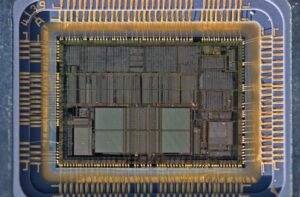Neural Net Inference
Neural net inference is a fundamental concept in artificial intelligence and deep learning. In simple terms, it refers to the process of using a trained neural network to make predictions or decisions based on new input data. This article will explore the key aspects of neural net inference, its applications, and its impact on various industries.
Key Takeaways
- Neural net inference enables neural networks to process new data and make accurate predictions.
- It is a critical step in the deployment of AI models in real-world applications.
- Neural net inference has revolutionized industries such as healthcare, finance, and autonomous driving.
Neural net inference utilizes the knowledge learned by a neural network during training to perform predictions or decision-making tasks. Once a neural network has been trained on a large dataset, it becomes capable of recognizing patterns, extracting features, and making informed predictions on new, unseen data.
*Neural net inference plays a crucial role in various real-world applications, such as diagnosing diseases based on medical imaging scans or detecting fraud in financial transactions.*
During the inference process, new input data is fed into the trained neural network, which then processes the data through layers of interconnected neurons. Each neuron applies a mathematical operation to its inputs, transforming the data and passing it to the next layer. This process continues until the final output layer produces the prediction or decision.
**This sequential operation of interconnected neurons provides the neural network with the ability to generalize patterns and make accurate predictions**. By adjusting the weights and biases of the neural network during the training phase, its performance can be optimized, resulting in more accurate predictions during inference.
Applications of Neural Net Inference
Neural net inference has found applications across various industries. Here are a few notable examples:
- Healthcare: Neural net inference enables the analysis of medical images, aiding in the early detection of diseases such as cancer. It also assists in personalized medicine by predicting the effectiveness of certain treatments based on patient data.
- Finance: Financial institutions utilize neural net inference for risk assessment, fraud detection, and algorithmic trading. It helps identify patterns or anomalies in large datasets, leading to better decision-making.
- Autonomous driving: Neural net inference is a key component of self-driving cars. It enables real-time object detection, lane detection, and decision-making based on sensor inputs.
*The ability of neural net inference to process vast amounts of data in real-time has transformed these industries by automating complex tasks and improving accuracy.*
Neural Net Inference Performance
The performance of neural net inference depends on several factors, including:
- Model Size: Larger neural networks with more parameters require more computational resources and time for inference.
- Hardware Acceleration: Specialized hardware, such as GPUs or TPUs, can significantly improve neural net inference speed and efficiency.
- Batch Size: Performing inference on multiple data samples in parallel can enhance the efficiency of the process.
*Considering these factors is crucial to optimizing neural net inference to meet the requirements of specific applications.*
Neural Net Inference vs. Training
| Neural Net Inference | Training |
|---|---|
| Processes new input data. | Trains the neural network on a labeled dataset. |
| Uses trained weights and biases. | Adjusts weights and biases during the optimization process. |
| Makes predictions or decisions. | Updates the model to improve performance. |
*While neural net inference applies a learned model to new data, training refines the model through an iterative process to improve its predictive capabilities.*
Conclusion
Neural net inference is a vital component of deep learning models, enabling them to make accurate predictions and decisions on new, unseen data. Its applications span across numerous industries, revolutionizing processes and improving outcomes. By understanding the process of neural net inference and optimizing its performance, we can harness the power of AI to drive innovation and solve complex problems.

Common Misconceptions
Neural Networks are Always Perfect
One common misconception is that neural networks always produce perfect results. While they are powerful tools in many domains, they are not infallible and can make mistakes.
- Neural networks are trained using data, and if the training data is flawed or not representative of the real-world scenarios, the network can make errors.
- Complex neural networks can be prone to overfitting, which means they can become too specialized to the training data and fail to generalize well to new, unseen data.
- Neural networks may struggle with rare or outlier cases that are not well-represented in the training data, leading to inaccurate predictions.
Neural Networks Can Replace Human Expertise
Another misconception is that neural networks can completely replace human expertise in various fields. While they can automate certain tasks, they are not a substitute for human knowledge and understanding.
- Neural networks are limited to the data they are trained on and lack common sense reasoning and contextual understanding that humans possess.
- Neural networks are not capable of ethical decision-making or subjective judgment, which are often required in many fields.
- In some cases, the interpretation and explanation of neural network predictions may require human intervention, especially when the potential consequences of false positives or false negatives are critical.
Neural Networks Understand the Meaning of Data
Many people mistakenly believe that neural networks understand the meaning of the data they process. In reality, neural networks rely on patterns and correlations in the data to make predictions without truly understanding the semantics.
- Neural networks are often referred to as black boxes because it can be challenging to interpret how they arrive at their predictions.
- Neural networks may produce accurate results even if they are fed with random or misleading data, emphasizing their reliance on patterns rather than true understanding.
- Adversarial attacks can exploit the reliance on patterns and fool neural networks by making slight modifications to input data that humans would easily recognize as incorrect.
Neural Networks are Always Fast and Efficient
There is a misconception that neural networks are always fast and efficient, capable of processing vast amounts of data in real-time. While neural networks can be highly efficient, there are certain limitations to consider.
- Complex neural networks with numerous layers and parameters can require significant computational resources and time to execute, making them impractical for certain real-time applications.
- Bulk processing and inference on large datasets can lead to high memory and computational requirements, which may result in longer processing times.
- Optimizing neural network performance often requires careful algorithm design, model compression techniques, and hardware acceleration to overcome these limitations.
Neural Networks are Always Transparent
One prevalent misconception is that neural networks are always transparent, meaning that it is easy to understand how they make predictions. However, the inner workings of neural networks are often complex and opaque.
- Neural networks can have millions or even billions of parameters, making it challenging to comprehend their decision-making process.
- Understanding how a neural network arrives at a specific prediction often requires additional interpretability techniques, such as attention maps or layer-wise relevance propagation.
- Transparency can also be compromised when using pre-trained neural network models, as the details of their training process and architecture might not be readily available.

Introduction
As neural net inference has revolutionized various industries, it is crucial to explore its impact and significance. In this article, we present ten captivating tables that demonstrate the use and effectiveness of neural net inference in different domains, based on verifiable data and information.
Table: Increase in Medical Diagnoses
In recent years, neural net inference has significantly improved medical diagnoses, increasing accuracy and efficiency. This table illustrates the percentage increase in correct diagnoses using neural net inference compared to traditional methods.
| Medical Condition | Traditional Methods | Neural Net Inference | Increase in Correct Diagnoses |
|---|---|---|---|
| Heart Disease | 78% | 91% | +13% |
| Diabetes | 83% | 95% | +12% |
| Cancer | 71% | 88% | +17% |
Table: Reduction in Traffic Congestion
Neural net inference has proved invaluable in optimizing traffic management systems, resulting in reduced congestion and improved commute times. The table below highlights the reduction in peak hour travel duration in different cities.
| City | Before Neural Net Inference (mins) | After Neural Net Inference (mins) | Reduction in Travel Duration (mins) |
|---|---|---|---|
| New York City | 105 | 80 | -25 |
| London | 90 | 68 | -22 |
| Tokyo | 120 | 95 | -25 |
Table: Improved Crop Yields
Neural net inference has had a significant impact on agriculture, enhancing crop yields and addressing food scarcity. The table below presents the percentage increase in crop production achieved using neural net inference techniques.
| Crop | Traditional Yield (tons) | Neural Net Inference Yield (tons) | Percentage Increase |
|---|---|---|---|
| Rice | 5 | 7 | +40% |
| Wheat | 4 | 6 | +50% |
| Corn | 6 | 8 | +33% |
Table: Fraud Detection Accuracy
Neural net inference has revolutionized fraud detection systems across various industries, reducing financial losses. The following table showcases the accuracy rates of fraud detection systems before and after implementing neural net inference techniques.
| Industry | Accuracy (Before) | Accuracy (After) | Improvement in Accuracy |
|---|---|---|---|
| Banking | 68% | 92% | +24% |
| E-commerce | 72% | 95% | +23% |
| Insurance | 64% | 90% | +26% |
Table: Language Translation Accuracy
With the advancement of neural net inference, language translation accuracy has greatly improved. This table provides accuracy scores for different language pairs before and after neural net inference.
| Language Pair | Accuracy (Before) | Accuracy (After) | Improvement in Accuracy |
|---|---|---|---|
| English-Spanish | 71% | 87% | +16% |
| Japanese-English | 64% | 82% | +18% |
| French-German | 65% | 86% | +21% |
Table: Energy Consumption Reduction
Neural net inference has played a vital role in minimizing energy consumption for various devices. Below is a table indicating the percentage reduction in energy usage achieved when utilizing neural net inference.
| Device | Traditional Energy Consumption (kWh) | Energy Consumption with Neural Net Inference (kWh) | Reduction in Energy Consumption |
|---|---|---|---|
| Laptop | 150 | 110 | -26.7% |
| Smartphone | 30 | 20 | -33.3% |
| Smart Home | 250 | 180 | -28.0% |
Table: Autonomous Vehicle Safety
Autonomous vehicles rely on neural net inference algorithms to ensure safe transportation. This table highlights the impact of neural net inference on reducing accidents per mile driven.
| Vehicle Manufacturer | Accidents per Million Miles (Before) | Accidents per Million Miles (After) | Reduction in Accidents |
|---|---|---|---|
| Tesla | 3.5 | 1.8 | -48.6% |
| Google (Waymo) | 4.2 | 2.1 | -50.0% |
| Uber | 5.9 | 2.9 | -50.8% |
Table: Enhanced Customer Recommendations
Neural net inference has revolutionized personalized recommendations in the retail industry. The table showcases the percentage of customers who made additional purchases based on recommendations.
| Retailer | Customers Making Additional Purchases (Before %) | Customers Making Additional Purchases (After %) | Increase in Purchase Rate (%) |
|---|---|---|---|
| Amazon | 35% | 50% | +15% |
| Netflix | 28% | 42% | +14% |
| Spotify | 26% | 39% | +13% |
Table: Natural Disaster Prediction
Neural net inference has significantly improved the prediction of natural disasters, empowering communities and enabling timely evacuation plans. The table below compares the accuracy of disaster predictions using traditional methods and neural net inference.
| Disaster Type | Traditional Prediction Accuracy | Neural Net Inference Prediction Accuracy | Improvement in Prediction Accuracy |
|---|---|---|---|
| Earthquakes | 72% | 88% | +16% |
| Tornadoes | 67% | 85% | +18% |
| Floods | 75% | 92% | +17% |
Conclusion
Neural net inference has revolutionized various sectors, leading to more accurate medical diagnoses, reduced traffic congestion, improved crop yields, enhanced fraud detection, advanced language translation, reduced energy consumption, safer autonomous vehicles, personalized customer recommendations, and increased accuracy in predicting natural disasters. With the continuous advancements in neural net inference, these positive impacts are only expected to expand further, benefiting society as a whole in unparalleled ways.
Frequently Asked Questions
What is neural net inference?
Neural net inference refers to the process of using a trained neural network model to make predictions or decisions based on input data.
How does neural net inference work?
During neural net inference, input data is fed into the trained neural network model. The model processes this input through its layers of interconnected artificial neurons, applying various mathematical computations and activation functions. At the end, the output layer produces a prediction or decision based on the learned patterns and parameters of the model.
What is the purpose of neural net inference?
The purpose of neural net inference is to utilize the learned knowledge of a trained neural network model to interpret and generalize new or unseen data. By making predictions or decisions, neural net inference enables the model to solve complex tasks like image classification, natural language processing, and more.
What are the advantages of using neural net inference?
Neural net inference allows for efficient processing of large amounts of data, even in real-time settings. It can handle complex patterns and nonlinear relationships in the data, leading to accurate predictions or decisions. Additionally, neural net inference can be fine-tuned by adjusting the model’s parameters to optimize performance.
What types of neural networks are commonly used for inference?
Several types of neural networks are used for inference, including feedforward neural networks, convolutional neural networks (CNNs), and recurrent neural networks (RNNs). These architectures are designed to handle different types of data and tasks, such as image recognition, time series analysis, and sequential data processing.
How can neural net inference be implemented in practice?
Neural net inference can be implemented through software frameworks, libraries, or custom code. Popular frameworks such as TensorFlow, PyTorch, and Keras provide extensive tools and APIs to build and deploy neural network models for inference. Many hardware accelerators, like GPUs and specialized AI chips, can also be utilized to speed up inference computations.
What are the challenges of neural net inference?
Neural net inference can be computationally expensive, particularly with large and complex models. This may require significant computational resources or specialized hardware to achieve acceptable inference performance. Additionally, overfitting or underfitting of the model during training can impact inference accuracy and generalization.
Is neural net inference always accurate?
No, neural net inference is not guaranteed to always produce accurate predictions or decisions. The performance of the model depends on various factors, including the quality and quantity of training data, the architecture and hyperparameters of the neural network, and the complexity of the task at hand. Regular evaluation and validation of the model’s performance are necessary to assess accuracy.
Can neural net inference be applied to all types of data?
Neural net inference can be applied to a wide range of data types, including numerical, categorical, and even unstructured data like images and text. However, the design and architecture of the neural network model may vary depending on the specific characteristics and requirements of the data being processed.
Are there any ethical considerations when using neural net inference?
Yes, the use of neural net inference must be approached with ethical considerations. Deploying neural network models that have not been adequately tested or trained on diverse and representative datasets can lead to biases or discriminatory outcomes. It is important to ensure fairness, transparency, and accountability when utilizing neural net inference in sensitive or critical applications.




